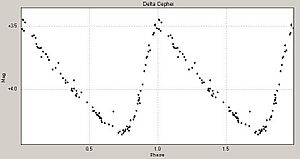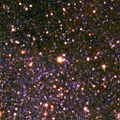Delta Cephei facts for kids

Delta Cephei (also called δ Cep) is a fascinating binary star system. It is located about 887 light-years away from Earth. You can find it in the northern constellation of Cepheus, which is named after a king. Even though it's very bright, some of its light is blocked by gas and dust between us and the star.
Delta Cephei is very important to astronomers. It was discovered by John Goodricke in 1784. It was only the second star of its kind ever found. These special stars are called Cepheid variables. Scientists know its distance from Earth very well. This is partly because it is part of a star cluster. Also, precise measurements from the Hubble Space Telescope and Hipparcos satellite helped. Because its distance is so well known, Delta Cephei is like a "standard ruler" in space. It helps scientists measure distances to other far-off galaxies. This is why it's called a "fundamental distance calibrator" or an "absolute candle". Delta Cephei is a classic type of Cepheid variable.
The only Cepheid variable star closer to us is Polaris, also known as the North Star. However, its exact distance is still being studied.
What Makes Delta Cephei Special?
Delta Cephei is incredibly bright. It shines with about 2,000 times the luminosity of our Sun. This huge amount of energy creates a strong "stellar wind". This wind, along with the star's pulsing and shocks in its atmosphere, causes it to lose mass. It loses about the mass of our Sun every million years! This matter flows outwards at a speed of about 35 kilometers per second.
The Nebula Around Delta Cephei
The gas that Delta Cephei pushes out forms a cloud around it. This cloud is called a nebula. It is about one parsec wide. A parsec is a unit of distance used in astronomy, equal to about 3.26 light-years. This nebula contains a lot of neutral hydrogen gas.
Where the star's wind crashes into the gas around it, a "bow shock" forms. Imagine a boat moving through water and creating a wave in front of it. The bow shock is similar, but it's happening in space with gas and dust.
Images for kids
-
Phase-folded UBVRI light curves of Delta Cephei showing how its brightness changes over time.
See also
 In Spanish: Delta Cephei para niños
In Spanish: Delta Cephei para niños




